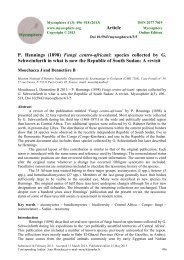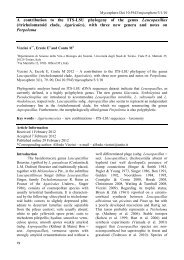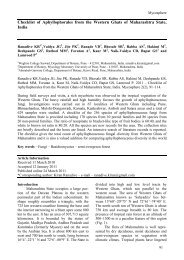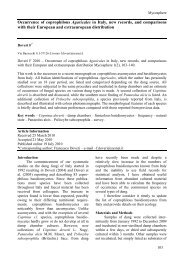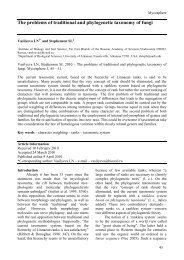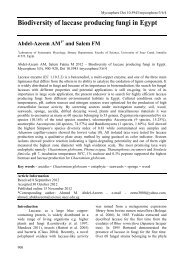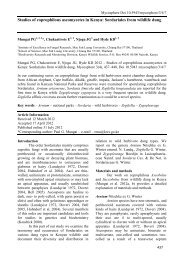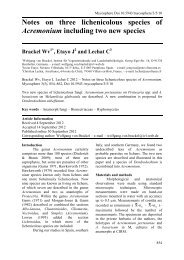Two interesting Pterula species from Maharashtra, India
Two interesting Pterula species from Maharashtra, India
Two interesting Pterula species from Maharashtra, India
You also want an ePaper? Increase the reach of your titles
YUMPU automatically turns print PDFs into web optimized ePapers that Google loves.
Mycosphere 4 (4): 766–771 (2013) ISSN 2077 7019<br />
www.mycosphere.org Article Mycosphere<br />
Copyright © 2013<br />
Online Edition<br />
Doi 10.5943/mycosphere/4/4/13<br />
<strong>Two</strong> <strong>interesting</strong> <strong>Pterula</strong> <strong>species</strong> <strong>from</strong> <strong>Maharashtra</strong>, <strong>India</strong><br />
Senthilarasu G<br />
National Facility for Culture Collection of Fungi, Mycology & Plant Pathology Group, Agharkar Research Institute,<br />
G. G. Agarkar road, Pune–411 004, <strong>India</strong>. Email – senthilarasug@rediffmail.com, senthilarasug28@gmail.com<br />
Senthilarasu G 2013 – <strong>Two</strong> <strong>interesting</strong> <strong>Pterula</strong> <strong>species</strong> <strong>from</strong> <strong>Maharashtra</strong>, <strong>India</strong>. Mycosphere 4(4),<br />
766–771, Doi 10.5943/mycosphere/4/4/13<br />
Abstract<br />
<strong>Two</strong> <strong>interesting</strong> <strong>species</strong> of clavarioid fungi <strong>Pterula</strong> indica sp. nov. and P. verticillata<br />
collected <strong>from</strong> Pune, <strong>Maharashtra</strong>, <strong>India</strong> are described, illustrated and discussed with closely allied<br />
<strong>species</strong>. Of these, <strong>Pterula</strong> indica is a new <strong>species</strong> characterized by the reddish brown to dark brown<br />
basidiomes, branched polychotomously below, dichotomously at the apex with white to yellowish<br />
white, acute apices, and having cylindric, smooth basidiospores and hyphoid to cylindric cystidia<br />
with short mucronate apex. <strong>Pterula</strong> verticillata is distinguished by pale orange to peach basidiomes<br />
that branched polychotomously below, verticillately to irregularly above, and having cylindric,<br />
smooth basidiospores and hyphoid cystidia with rostrate apex.<br />
Key words – Basidiomycota – clavarioid fungi – fungal diversity – macrofungi – taxonomy<br />
Introduction<br />
A worldwide monograph of clavarioid fungi was provided by Corner (1950, 1970) in<br />
which, all the recognized taxa were critically revised and classified. Later, Petersen extensively<br />
studied the type specimens and contributed significantly on the knowledge of taxonomy of<br />
clavarioid fungi occurring in different regions (1966, 1967a,b, 1968a,b, 1969, 1971a,b, 1978a,b,<br />
1979, 1984, 1988a,b). Pegler & Young (1985) studied the basidiospore structures in Ramariopsis<br />
and allied genera such as Clavulinopsis and Scytinopogon. Garcia-Sandoval et al. (2005), Dentinger<br />
& Laughlin (2006) and Kautmanová et al. (2012) studied the phylogenetic analysis of clavarioid<br />
fungi. Several clavarioid fungi have been recently described <strong>from</strong> different regions (Zhang et al.<br />
2005, Olariaga & Salcedo 2009, Young & Fechner 2009). Thind (1961) made a significant<br />
contribution on <strong>India</strong>n clavarioid fungi and compiled a monograph „The Clavariaceae of <strong>India</strong>‟.<br />
The <strong>species</strong> included were largely collected <strong>from</strong> Himalayas and a few <strong>from</strong> West Bengal, <strong>India</strong>.<br />
One of the genera of clavarioid fungi, <strong>Pterula</strong> Fr. (<strong>Pterula</strong>ceae Corner) is characterized by the<br />
erect, branched to simple, filiform and minute basidiomes having dimitic hyphal system with<br />
hyaline skeletal hyphae in the context. The genus comprises of about 50 <strong>species</strong> distributed<br />
worldwide particularly in tropics (Kirk et al. 2008). However, only two <strong>species</strong> P. decumbens<br />
Corner, Thind & Dev (Corner et al. 1957) and P. penicillata Lloyd (Thind 1961) have been<br />
described so far <strong>from</strong> <strong>India</strong>. However, Thind (1961) clearly stated that the identity of P. penicillata<br />
collected by P.L. Day is doubtful and no description was provided. Instead of describing the<br />
fungus, Lloyd (1919-1925) merely provided one illustration for this fungus and he thought the<br />
fungus was similar to the collection made <strong>from</strong> USA. Corner (1950) felt based on the illustration<br />
provided by Lloyd (1919-1925) that it could be P. verticillata Corner. Apparently, there are no<br />
Submitted 1 April 2013, Accepted 26 July 2013, Published online 13 August 2013<br />
Corresponding Author: Senthilarasu G – e-mail – senthilarasug@rediffmail.com 766
other reports of this genus <strong>from</strong> <strong>India</strong>. The knowledge on diversity of clavarioid fungi <strong>from</strong><br />
Western Ghats of southern <strong>India</strong> is scanty. A total of only 19 <strong>species</strong> viz., Clavaria zollingeri,<br />
Clavulina cristata, C. rugosa, Clavulinopsis aurantiocinnabarina, C. corniculata, C. dichotoma, C.<br />
fusiformis, C. laeticolor, C. luteoalba, Ramaria apiculata, R. cokeri, R. eumorpha, R. flava, R.<br />
Formosa, R. gracilis, R. pallid, R. versatilis, Ramariopsis kunzei and R. pulchella have been<br />
recorded <strong>from</strong> Kerala state (Mohanan 2011) and only one <strong>species</strong> Ramaria zippelii has been<br />
recorded <strong>from</strong> Western Ghats of <strong>Maharashtra</strong> (Senthilarasu 2013). Hence, a study was initiated on<br />
clavarioid fungi of Western Ghats. In the present paper, <strong>Pterula</strong> indica collected <strong>from</strong> Pune<br />
University Campus, Pune is described, illustrated and discussed with similar taxa. <strong>Pterula</strong><br />
verticillata is being reported for the first time <strong>from</strong> Western Ghats.<br />
Methods<br />
Thin sections were made <strong>from</strong> dried specimens, revived in 10% KOH, and stained in 2%<br />
Phloxine. Approximately 50 basidiospores <strong>from</strong> sections were measured excluding the apiculus and<br />
ornamentation. The range of spore measurements with extreme values in parentheses precedes the<br />
mean spore measurement in parentheses. The colour terms and notations are <strong>from</strong> Kornerup &<br />
Wanscher (1978). The type specimens are deposited at Ajrekar Mycological Herbarium (AMH),<br />
MACS‟ Agharkar Research Institute, Pune, <strong>India</strong>.<br />
Results<br />
<strong>Pterula</strong> indica G. Senthilarasu sp. nov.<br />
Figs. 1, 3B<br />
MycoBank 561873.<br />
Etymology – The epithet „indica‟ refers that this <strong>species</strong> is collected and described <strong>from</strong><br />
<strong>India</strong>.<br />
Differs <strong>from</strong> P. verticillata in having reddish brown to dark brown basidiomes with<br />
branches polychotomous below and dichotomous at the yellowish white apex and hyphoid to<br />
cylindric cystidia with mucronate apex.<br />
Material examined – <strong>India</strong>, <strong>Maharashtra</strong> state, Pune, Pune University Campus<br />
(18°31′18.4"N 73°49′53.6"E), on ground (soil), Acacia forest, 19.10.2010, Dalbergia plantations,<br />
28.09.2011. Collected by G. Senthilarasu (Holotype AMH 9430).<br />
Basidiomes terrestrial, 50–75 × 50–200 mm, gregarious or in clumps, erect, branched<br />
polychotomously below, dichotomously at the apex, tubular. Stipe short, up to 10 × 20 mm, brittle;<br />
surface reddish brown (8E8) to dark brown (8F8), becoming dark, apices white to yellowish white<br />
(4A2), subulatus, acute, glabrous.<br />
Basidiospores (4.5)5–7 × (2)3–3.5(4), (6.12±0.53 × 2.96±0.12) µm, Q = 2.06, cylindric,<br />
hyaline, smooth, thin-walled, 1–2 guttulate. Basidia 20–32 × 7.5–9.5 µm, cylindric clavate,<br />
bisporic to tetrasporic, sterigmata up to 4 × 1 µm, thin-walled, guttulate. Cystidia 18–26.5 × 4.5–<br />
5.5 µm, hyphoid to cylindric with short mucronate apex, hyaline, thin-walled. Hyphal system<br />
dimitic, skeletal hyphae up to 8.5 µm diam., thick-walled, subhyaline to yellowish brown, not<br />
inflated; generative hyphae 2–5 µm diam., hyaline, not inflated, thin-walled with clamp<br />
connections.<br />
<strong>Pterula</strong> indica is very striking <strong>species</strong> growing largely on soil, is easily recognized by the<br />
reddish brown to dark brown basidiomes with white to yellowish white apices. <strong>Pterula</strong> verticillata<br />
differs <strong>from</strong> P. indica in having pale orange to peach basidiomes that branched profusely in<br />
verticillate manner. In addition, the branches are shiny and lucidus in P. verticillata. Whereas, the<br />
basidiomes of P. indica are branched polychotomously below and dichotomously at the apex.<br />
<strong>Pterula</strong> subulata Fr. differs <strong>from</strong> P. indica in having subulate, white to grayish basidiomes and<br />
presence of large, ovoid spores (8–10 × 5–7 µm vs 4.5–7 × 2–4 µm). <strong>Pterula</strong> gracilis (Desm. &<br />
Berk.) Corner (Corner 1950) has white, shiny, translucent, slightly hairy, simple and unbranched<br />
basidiomes. Whereas, P. indica has reddish brown to dark brown, profusely branched, dull, smooth<br />
basidiomes having white, acute apices.<br />
767
Fig. 1 – <strong>Pterula</strong> indica. Macroscopic features. a Basidiomes in situ (Holotype AMH 9430). b<br />
Individual basidiome. Photos by G. Senthilarasu.<br />
<strong>Pterula</strong> verticillata Corner<br />
Figs 2, 3A<br />
Specimens Examined – INDIA, <strong>Maharashtra</strong> state, Pune, Pune University Campus<br />
(18°31′18.4"N 73°49′53.6"E), on ground (soil), Acacia forest, 13.08. 2010, 28.09.2011. Collected<br />
by G. Senthilarasu. (AMH 9429, AMH 9458).<br />
Basidiomes 20–40 × 20–50 mm, erect. Stipe rudimentary to well developed, 10–25 × 3–5<br />
mm, cylindrical, main axis arising <strong>from</strong> mycelial threads, binding the base of the basidiomes<br />
closely to the substrate, initially colourless, translucent, profusely branched, polychotomous below,<br />
verticillately to irregularly branched above, cylindric, sterile apices acute, branches initially<br />
translucent, becoming shiny in age, apices remaining translucent even in matured branchlets;<br />
surface pale orange (5A3, 6A3) to peach (7A4). Axils acute to subacute; branchlets divergent; very<br />
thin, becoming hairy on drying.<br />
768
Basidiospores (5)6–7(7.5) × (2.5)3–3.5, (6.53±0.6 × 3.15±0.23) µm, Q = 2.07, cylindric,<br />
hyaline, smooth, apiculus not prominent, guttulate, 1–2 small guttules present. Basidia 12–18 × 6–<br />
8 µm, cylindrical, becoming short clavate, bisporic to tetrasporic, sterigmata short and thin,<br />
guttulate, thin-walled. Cystidia 14–60 × 5–7 µm, hyphoid with long rostrate apex, hyaline, thinwalled.<br />
Hyphal system dimitic; skeletal hyphae up to 7 µm diam., thick-walled, wall up to 1 µm<br />
thick, brown; generative hyphae 1–4 µm diam., inflated to 10 µm diam., hyaline, yellowish brown<br />
in mass, thin-walled with clamp connections.<br />
<strong>Pterula</strong> verticillata is a very distinctive <strong>species</strong> growing largely on soil, occupies large area<br />
of soil and the mycelium also extensively colonize the litter and produce basidiomes every year<br />
during monsoon (August–October). <strong>Pterula</strong> verticillata closely resembles P. decumbens (Corner et<br />
al. 1957) described <strong>from</strong> <strong>India</strong>. However, P. decumbens clearly differs <strong>from</strong> P. verticillata by its<br />
decumbent, brown basidiomes, and composed of main axis which gives off lateral branches,<br />
attached to the substratum by numerous rhizoidal branches. Whereas P. verticillata has erect, pale<br />
orange to peach basidiomata and the main axis gives off verticillate to irregular branches.<br />
Fig. 2 – <strong>Pterula</strong> verticillata. Macroscopic features. a. Basidiomes in situ. b. Individual basidiome.<br />
Photos by G. Senthilarasu.<br />
769
Fig. 3 – A <strong>Pterula</strong> verticillata. a. Basidiospores. b. Basidia. c. Cystidia. d. Generative hypha with<br />
clamp connection. B <strong>Pterula</strong> indica. a. Basidiospores. b. Basidia. c. Cystidia. d. Generative hyphae<br />
with clamp connections. Scale Bar = 10 µm.<br />
Acknowledgements<br />
I Sincerely thank the Department of Science and Technology (DST), Government of <strong>India</strong>,<br />
New Delhi, for providing financial support under the IRPHA Programme for setting up state-of theart<br />
National Facility for Culture Collection of Fungi (No. SP/SO/PS-55/2005) at Agharkar<br />
Research Institute, Pune, <strong>India</strong>. Sincere thanks to the Director, Agharkar Research Institute for<br />
providing laboratory facilities.<br />
References<br />
Corner EJH. 1950 – A monograph of Clavaria and allied genera. Oxford University Press, London,<br />
UK. 740p.<br />
Corner EJH. 1970 – Supplement to “A monograph of Clavaria and allied genera”. Beih. Nova<br />
Hedwigia 33: 1–299.<br />
Corner EJH, Thind KS, Dev S. 1957 – The Clavariaceae of the Mussoorie Hills (<strong>India</strong>). VII.<br />
Transactions of British Mycological Society 40(4), 472–476.<br />
Dentinger BTM, McLaughlin DJ. 2006 – Reconstructing the Clavariaceae using nuclear large<br />
subunit rDNA sequences and a new genus segregated <strong>from</strong> Clavaria. Mycologia 98(5), 746–<br />
762. http://dx.doi.org/10.3852/98.5.746<br />
Garcia-Sandoval R, Cifuentes J, Luna ED, Estrada-Torres A, Villegas M. 2005 – A phylogeny of<br />
Ramariopsis and allied taxa. Mycotaxon 94, 265–292.<br />
Kautmanová I, Adamčík S, Lizoň P, Jančovičová S. 2012 – Revision of taxonomic concept and<br />
systematic position of some Clavariaceae <strong>species</strong>. Mycologia 104, 521–539.<br />
http://dx.doi.org/10.3852/11-121<br />
Kirk PM, Cannon PF, Minter DW, Stalpers JA. 2008 – Dictionary of the Fungi. 10 th edn. CAB<br />
International, UK. 771p.<br />
Kornerup A, Wanscher JH. 1978 – Methuen handbook of colour. 3rd edn. Methuen and Co., Ltd.,<br />
London. 243 p.<br />
Lloyd CG. 1919–1925 – Mycological notes. Cincinnati, Ohio, USA. 1364 p.<br />
770
Mohanan C. 2011. Macrofungi of Kerala. Kerala Forest Research Institute, Peechi, <strong>India</strong>. 597pp.<br />
Olariaga I, Salcedo I. 2009 – <strong>Two</strong> new <strong>species</strong> of Typhula <strong>from</strong> the Iberian Peninsula: T.<br />
ochraceosclerotiata and T. schoeni. Mycological Progress 8, 351–357.<br />
http://dx.doi.org/10.1007/s11557-009-0608-2<br />
Pegler DN, Young TWK. 1985 – Basidiospore structure in Ramariopsis (Clavariaceae).<br />
Transactions of British Mycological Society 84(2), 207–214.<br />
Petersen RH. 1966 – Notes on clavarioid fungi. V. Emendation and additions to Ramariopsis.<br />
Mycologia 58, 201–207.<br />
Petersen RH. 1967a – Type studies in the clavarioid fungi. I. Taxa described by Charles Horten<br />
Peck. Mycologia 59, 767–802.<br />
Petersen RH. 1967b – Type studies in the Clavariaceae. Sydowia 21, 105–122.<br />
Petersen RH. 1968a – Type studies in the clavarioid fungi. II. Nova Hedwigia 14, 407–414.<br />
Petersen RH. 1968b – The genus Clavulinopsis in North America. Mycol Mem 2, 1–39.<br />
Petersen RH. 1969 – Notes on clavarioid fungi. X. New <strong>species</strong> and type studies in Ramariopsis,<br />
with a key to <strong>species</strong> in North America. Mycologia 61, 549–559.<br />
Petersen RH. 1971a – Type studies in the clavarioid fungi. IV. Specimens <strong>from</strong> herbarius Fries at<br />
Uppsala with notes on cantharelloid <strong>species</strong>. Friesia 9, 369–388.<br />
Petersen RH. 1971b – Notes on clavarioid fungi. IX. Adendum to Clavulinopsis in North America.<br />
Persoonia 6, 219–229.<br />
Petersen RH. 1978a – The genus Ramariopsis in southeastern Australia. Australian Journal of<br />
Botany 26, 425–431.<br />
Petersen RH. 1978b – Notes on clavarioid fungi. XV. Reorganization of Clavaria, Clavulinopsis<br />
and Ramariopsis. Mycologia 70(3), 660–671.<br />
Petersen RH. 1979 – Notes on clavarioid fungi. XVII. Clavulinopsis taxa in southeastern Australia.<br />
Sydowia 32, 209–223.<br />
Petersen RH. 1984 – Type studies in clavarioid fungi. VIII. Persoonia 12, 225–237.<br />
Petersen RH. 1988a – The clavarioid fungi of New Zealand. In: Ruscoe QW, ed. Science<br />
Information Publishing Center, DSIR Bulletin, Wellington, NewZealand. 170 p.<br />
Petersen RH. 1988b – Notes on clavarioid fungi. XXII. Three <strong>interesting</strong> South American<br />
collections. Mycologia 80(4), 571–576. doi:10.2307/3807861<br />
Senthilarasu G. 2013. An <strong>interesting</strong> blue <strong>species</strong> of Ramaria <strong>from</strong> Western Ghats, <strong>India</strong>. Kavaka.<br />
(accepted for publication).<br />
Thind KS. 1961 – The Clavariaceae of <strong>India</strong>. <strong>India</strong>n Council of Agricultural Research, New Delhi,<br />
197 p.<br />
Young AM, Fechner NA. 2009 – Australian coralloid fungi II–a new <strong>species</strong> of Ramaria<br />
(Gomphales) <strong>from</strong> Western Australia: Ramaria citrinocuspidata sp. nov. Australian<br />
Mycologist 28, 65–67.<br />
Zhang P, Yang ZL, Ge ZW. 2005 – <strong>Two</strong> new <strong>species</strong> of Ramaria <strong>from</strong> southwestern China.<br />
Mycotaxon 94, 235–240.<br />
771



